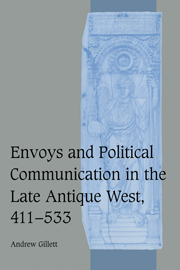Book contents
- Frontmatter
- Contents
- List of tables
- Preface
- List of abbreviations
- Chronological table
- Maps
- 1 EMBASSIES AND POLITICAL COMMUNICATION IN THE POST-IMPERIAL WEST
- 2 THE PROVINCIAL VIEW OF HYDATIUS
- 3 THE HERO AS ENVOY: SIDONIUS APOLLINARIS' PANEGYRIC ON AVITUS
- 4 THE SAINT AS ENVOY: FIFTH- AND SIXTH-CENTURY LATIN BISHOPS' LIVES
- 5 CASSIODORUS AND SENARIUS
- 6 NEGOTIUM AGENDUM
- CONCLUSION
- Appendix I Chronology of Constantius, Vita Germani
- Appendix II Chronology of the life of Epiphanius of Pavia
- Appendix III Senarius' Letters of Appointment: Cassiodorus, Variae IV, 3 and 4
- Appendix IV The text of Senarius' Epitaph
- Note on editions, commentaries, and translations of major sources
- Bibliography
- Index
- Cambridge Studies in Medieval Life and Thought Fourth series
4 - THE SAINT AS ENVOY: FIFTH- AND SIXTH-CENTURY LATIN BISHOPS' LIVES
Published online by Cambridge University Press: 12 July 2009
- Frontmatter
- Contents
- List of tables
- Preface
- List of abbreviations
- Chronological table
- Maps
- 1 EMBASSIES AND POLITICAL COMMUNICATION IN THE POST-IMPERIAL WEST
- 2 THE PROVINCIAL VIEW OF HYDATIUS
- 3 THE HERO AS ENVOY: SIDONIUS APOLLINARIS' PANEGYRIC ON AVITUS
- 4 THE SAINT AS ENVOY: FIFTH- AND SIXTH-CENTURY LATIN BISHOPS' LIVES
- 5 CASSIODORUS AND SENARIUS
- 6 NEGOTIUM AGENDUM
- CONCLUSION
- Appendix I Chronology of Constantius, Vita Germani
- Appendix II Chronology of the life of Epiphanius of Pavia
- Appendix III Senarius' Letters of Appointment: Cassiodorus, Variae IV, 3 and 4
- Appendix IV The text of Senarius' Epitaph
- Note on editions, commentaries, and translations of major sources
- Bibliography
- Index
- Cambridge Studies in Medieval Life and Thought Fourth series
Summary
Through the intercession and merit of the priest, a king was restrained, an army recalled, provinces spared from devastation.
Constantius, Vita Germani Autissiodorensis, 28Besides Sidonius' Panegyric on Avitus, the most extensive dramatisations of embassies in late antique Latin literature occur in several hagiographic Lives of bishops. Scenes of bishops undertaking legations to rulers on behalf of their communities are well-known attestations of the increasing involvement of the episcopacy in public functions, in turn a reflection of the annexation of the office of bishop by members of the provincial aristocracy. Such tableaux also appear to give evidence of a concomitant ebb of municipal and imperial authority, a vacuum filled perforce by the church. This latter impression is misleading. Embassies appear in late fifth- and early sixth-century hagiography precisely because the undertaking of legations was a common but prestigious political occurrence in secular centres of power, carried out by non-ecclesiastics including provincial magnates and palatine officials. Authors of episcopal biographies sought to appropriate for their subjects the social credit attached to this function. The impression that bishops shouldered the burden of municipal duties in undertaking embassies stems from the general invisibility of non-ecclesiastic envoys in the sources. A series of Vitae show the growth of a new saintly image, a distinct extension of earlier hagiographic types, which flourished between the late fifth and mid-sixth centuries. These Vitae were a reaction to the increasing social value of the role of envoy in public life.
- Type
- Chapter
- Information
- Publisher: Cambridge University PressPrint publication year: 2003
- 2
- Cited by

